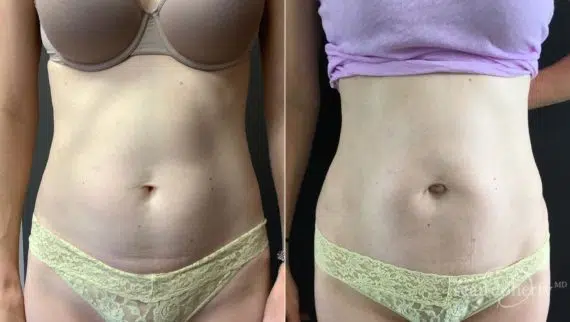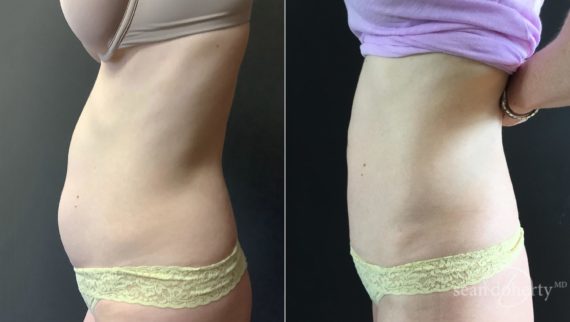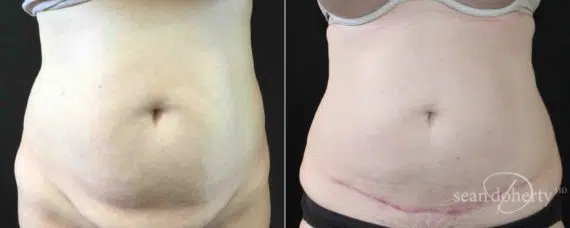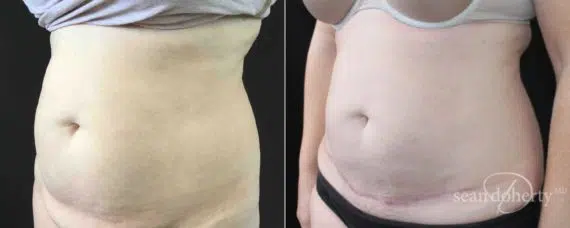
If you ask any woman to describe her dream body, a flatter abdomen is probably near the top of the list. But sometimes, no matter how carefully you eat or how much you exercise, that dreaded fat tire remains. While some dreams, like gazelle legs, may be impossible to attain without growth serum, a bathing suit ready abdomen is actually achievable. A mini-tummy tuck is a surgical procedure to remove excess skin and fatty tissue in the abdominal region. However, unlike a fully tummy tuck or abdominoplasty, a mini-tummy tuck only addresses the lower portion of the abdomen, below the belly button. This is why it is so important that you be assessed in person.
During your mini-tummy tuck consultation at one of his Boston area offices, board certified plastic surgeon Dr. Sean Doherty will listen to what, exactly, it is that bothers you about your body contour. Next, he will perform a full physical exam to evaluate the degree of skin laxity in your abdomen, where this loose skin is located and whether or not you also have some underlying lax muscle. Then, together, you will come up with the treatment plan that best suits your goals, lifestyle and anatomy. While a mini-tummy tuck can be performed alone, Dr. Doherty will often combine it with liposuction of the waist, hips and flanks in order to re-contour the look of your entire torso.
Advantages of a Mini-Tummy Tuck
As the name implies, a mini-tummy tuck is a smaller or less intense version of the full tummy tuck. Because of this, there are certain advantages to having a mini-tummy tuck. These include:
- a shorter incision
- no surgical manipulation of the umbilicus or belly button
- quicker recovery time
However, just because some patients may think of this as “tummy tuck light”, this is still surgery. It will require general anesthesia, incisions and a recovery period in which you will not be able to stand up completely straight. This is why it’s not worth getting a mini-tummy tuck unless it can truly correct your issues.
Are You a Candidate for a Mini-Tummy Tuck?
The fundamental difference between a mini and full tummy tuck is that a mini-tummy tuck only corrects skin laxity below the belly button. There are any number of things that can cause your belly to pooch. Some women are simply genetically blessed to carry more fat in their abdomen. For most, however, age, pregnancy and weight gain/loss stretch the skin and muscles of the abdomen past the point where diet and exercise alone can really make a difference.
While a mini-tummy tuck can be a great alternative for patients who have a moderate amount of loose skin and/or fat below the navel or belly button, it is not usually the right procedure for anyone who’s had children or gained and lost a significant amount of weight. Why? Because pregnancy and weight fluctuations stretch the skin from the breast bone to the top of the pubic bone. Furthermore, they can also result in diastasis or a looseness of the abdominal wall or core. This muscle looseness is actually a separation or splaying of the abdominal muscles that must be “corseted” back together. Doing so requires a full tummy tuck.
Mini-Tummy Tuck Procedure
A mini-tummy tuck may be performed under sedation or general anesthesia at an accredited surgical center or hospital. During your abdominal procedure, Dr. Doherty will place a small, horizontal incision in your pubic area. It’s typically located right above the pubic hair line where it can easily be hidden by your swimsuit or undergarments. Dr. Doherty has all of his tummy tuck patients bring these garments into their pre-operative visit in order to assist him in planning the incision placement.
In the operating room, Dr. Doherty will pull down and remove the excess skin and fatty tissue in the lower region of the abdomen. Since he takes a 360° approach with all of his body contouring patients, liposuction will often be combined with a mini-tummy tuck in order to re-shape the flanks. The result is a firm, toned-looking abdomen with a trim waistline.
Mini-Tummy Tuck Recovery
You can expect your abdomen to feel tight after surgery. But Dr. Doherty encourages his patients to get out of bed and walking as soon as possible This will not only improve your circulation, but it will also help your muscles to get used to their new position and speed along your healing process.
A mini-tummy tuck may be less intense than a full tummy tuck, but it is still surgery. And any time that the skin is cut, it causes swelling. This is the body’s way of healing. But swelling can also cause pain. An abdominal binder and/or surgical garment helps to reduce swelling which is why Dr. Doherty has his abdominoplasty patents wear one for a few weeks after surgery. It’s basically like wearing Spanx. Uncomfortable, but worth it in the long run.
Every patient heals at his or her own rate. Most, however, can expect to be bruised and swollen for at least two weeks. You want to avoid lifting and bending for 3-4 weeks. But after this time, your body should be healed enough to return to most non-strenuous activities as well as light exercise. Patients are not able to drive while on pain medicine, nor should they be the primary care takers of children so make sure to plan appropriately.
Benefits of a Mini-Tummy Tuck
A mini-tummy tuck can restore a smoother, flatter appearance to your abdomen. This, in turn, can radically improve a patient’s self-esteem. Not only will your clothes fit better, but most patients claim that they feel more youthful and energetic after a mini-tummy tuck. Furthermore, this procedure improves posture which can reduce the incidence of stress urinary incontinence. All in all, restoring a more youthful contour to your abdomen is good for your soul.
To find out more about a mini-tummy tuck with Dr. Sean Doherty at his Boston or Chestnut Hill office, contact us today or call (617) 450.0070 to schedule a consultation.












